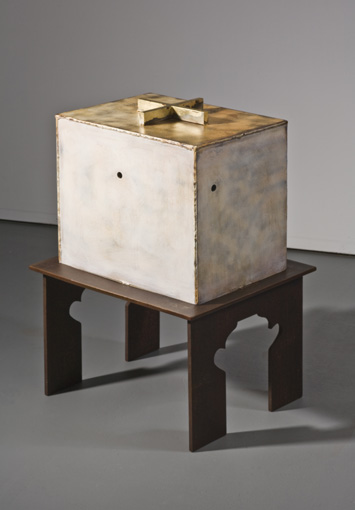
David Kimball Anderson’s Roman Ascetism at Bellas Artes
David Kimball Anderson is a metallurgist whose new show at Bellas Artes Gallery, Travel: Rome, Namche is full of steel constructions that are simple if not austere. He traveled to Rome in 2009 for the first time and muses that he spent 45 minutes alone with Bernini’s Apollo and Daphne. His show materialized from this trip, and was also informed by the story of a friend who fell ill while traveling in Kathmandu, Nepal, and was saved by the villagers’ kind ingenuity. Here is a peek at the show that opened in Santa Fe (at Bellas Artes, 653 Canyon Road) on Saturday evening.
Rome, WaterRome, Water (2010) is a neatly squared metal box measuring 37” x 25” x 20”. It sits in the center of the gallery space, too large to be an urn and too short to be a coffin. The title suggests it’s a vessel for water—possibly a boarded trough? It looks mildly severe sitting remotely in the empty space. Anderson painted it to look distressed and old with earthy browns and subtle gold undertones that aid the metal’s varied surface in offering a rustic container that begs for recognition. A twig sprouting a few delicate white flowers ascends upon one corner. Also forged from steel, they look perky in their crisp white and summer green paint, juxtaposing life upon this worn vessel. Six holes about the size of pennies are spaced evenly on the top. One is closed (or was probably never open), giving the illusion that time and earth corroded over the gap and filled it with compost.
Naturally Anderson’s work is not old but functions as “visual postcards.” They don’t claim to be reproductions by tricking the viewer into believing their antiquity but rather sit respectfully and restful, paying homage to their ancestors like a contemplative sage or quiet Rome wanderer amid an old church.

Rome, Santa Teresa
Rome, Santa Teresa has a cross on the top, placed dead center and dripped in matte gold. The sides of this steel box are finished with a white patina, rough and uneven to show browns beneath. Rome, Santa Teresa sits on top of a low table and suggests the resting ground of some sacred relics. But they are not so much emblematic of Bernini’s St. Teresa struck with ecstasy as ascetic and plain, as if a Shaker ceremony intervened in the high Catholic traditions, evoking a reservedness and subtleness not without beauty. Something sacred could be hidden in the midst of these faux-finished slates of steel and we would easily graze by in admiration.
Similarly, Namche, Cornice shows a wooden corner protruding high from the wall. Actually made from steel, this architectural slice is finished to resemble all too convincingly weathered wood. Dangling from it are squares of brightly colored fabric cut from t-shirts and lined on a rope to mirror a Tibetan prayer flag. Netting is caught in their midst as it hangs off the precipice like Rapunzel’s thick hair. The colored squares are not painted with auspicious words but fall unadorned in the same simplicity as Anderson’s Roman relics, quietly prompting a spark to memory that signals a whole well.
Namche, Cornice
